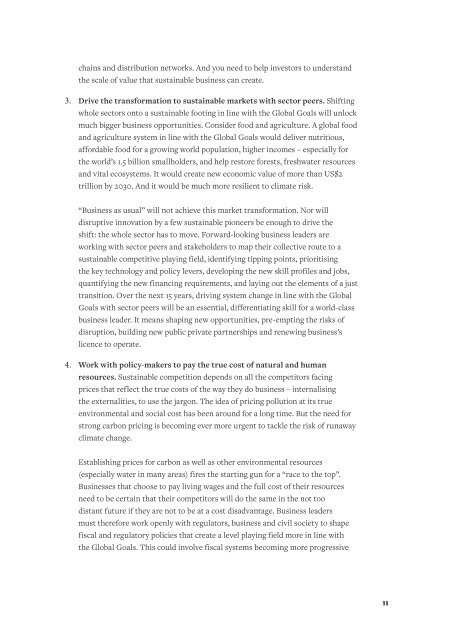BETTER BUSINESS BETTER WORLD
2jxE7K2
2jxE7K2
You also want an ePaper? Increase the reach of your titles
YUMPU automatically turns print PDFs into web optimized ePapers that Google loves.
chains and distribution networks. And you need to help investors to understand<br />
the scale of value that sustainable business can create.<br />
3. Drive the transformation to sustainable markets with sector peers. Shifting<br />
whole sectors onto a sustainable footing in line with the Global Goals will unlock<br />
much bigger business opportunities. Consider food and agriculture. A global food<br />
and agriculture system in line with the Global Goals would deliver nutritious,<br />
affordable food for a growing world population, higher incomes – especially for<br />
the world’s 1.5 billion smallholders, and help restore forests, freshwater resources<br />
and vital ecosystems. It would create new economic value of more than US$2<br />
trillion by 2030. And it would be much more resilient to climate risk.<br />
“Business as usual” will not achieve this market transformation. Nor will<br />
disruptive innovation by a few sustainable pioneers be enough to drive the<br />
shift: the whole sector has to move. Forward-looking business leaders are<br />
working with sector peers and stakeholders to map their collective route to a<br />
sustainable competitive playing field, identifying tipping points, prioritising<br />
the key technology and policy levers, developing the new skill profiles and jobs,<br />
quantifying the new financing requirements, and laying out the elements of a just<br />
transition. Over the next 15 years, driving system change in line with the Global<br />
Goals with sector peers will be an essential, differentiating skill for a world-class<br />
business leader. It means shaping new opportunities, pre-empting the risks of<br />
disruption, building new public private partnerships and renewing business’s<br />
licence to operate.<br />
4. Work with policy-makers to pay the true cost of natural and human<br />
resources. Sustainable competition depends on all the competitors facing<br />
prices that reflect the true costs of the way they do business – internalising<br />
the externalities, to use the jargon. The idea of pricing pollution at its true<br />
environmental and social cost has been around for a long time. But the need for<br />
strong carbon pricing is becoming ever more urgent to tackle the risk of runaway<br />
climate change.<br />
Establishing prices for carbon as well as other environmental resources<br />
(especially water in many areas) fires the starting gun for a “race to the top”.<br />
Businesses that choose to pay living wages and the full cost of their resources<br />
need to be certain that their competitors will do the same in the not too<br />
distant future if they are not to be at a cost disadvantage. Business leaders<br />
must therefore work openly with regulators, business and civil society to shape<br />
fiscal and regulatory policies that create a level playing field more in line with<br />
the Global Goals. This could involve fiscal systems becoming more progressive<br />
98


